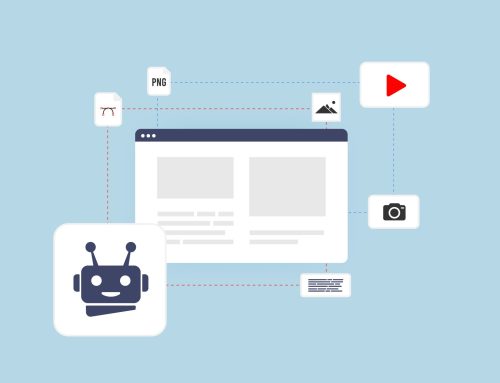Table of Contents
- How to Keep Your Writing on Track
- Step 1: Make Sure Your Blog Article Idea is Worthwhile
- Step 2: Find Your Blog Article Title
- Step 3: Write Down Your Blog Article’s Key Points
- Step 4: Research What You Don’t Know About your Blog Topic
- Step 5: Organize Your Blog’s Key Points & Group Your Data
- Step 6: Develop Your Blog Article’s Key Points & Research More
- Step 7: Reorganize and Edit Your Blog Article Again
- Step 8: Revisit Your Blog Article Title and Headings
- Step 9: Write Your Blog Article’s First Draft!
We detail 9 steps our agency follows so you can ensure your blog post outline will set you up for success.

When you sit down to write a blog post, you might feel inclined to let the words flow naturally, and develop your article around the organic way it’s written. While it’s tempting to let your blog take shape as you write it, it could end up harming your final article for a number of reasons, such as:
- The structure might be awkward and not flow well
- You could be missing crucial supporting evidence for what you’re writing about
- The topic of your blog or supporting points might not even be worthwhile to write about
By outlining your blog post beforehand, you can avoid those common pitfalls often found in online blog posts.
But what exactly is a blog outline? Simply put, it’s a way to organize your thoughts on a topic before fully writing it. Not only will this help you stay on track when you go to write your full article, it can also help you hone in your main topic and supporting points.
The way a writer prefers to outline their articles can vary from person to person. So although there are different ways to outline a blog, they generally follow the steps we discuss in our post. And yes, we used a blog outline to help create this post!
How to Keep Your Writing on Track
When you begin your blog outline, you might think it’s not helping you stay focused on your main topic. Your ideas might be flowing to the point where it feels unstructured and pointless to create an outline first, but rest assured this a common part of the process. Following the nine steps below can help you start off on a strong note and result in a great outline ready for future writing.
Step 1: Make Sure Your Blog Article Idea is Worthwhile
To start outlining a blog, you need a good topic to start with. How do you know if your idea is any good? Will anyone want to read what you have to write? Before putting in all the effort of outlining and writing, we recommend doing a little research beforehand to help answer these fundamental questions.
Tools like Ahrefs Keywords Explorer can help you determine how many people are searching for your topic and how hard it will be to rank for it on Google. Finding a keyword that has a high search volume but low keyword difficulty (how hard it will be to rank for that keyword) is the sweet spot you’ll want to find. This initial research should also include seeing what’s already written so you can make your content unique and fill in gaps of knowledge where the other articles might have failed.
If you’re having trouble finding a keyword that’s worthwhile to write about, we suggest looking into long tail keywords, which are longer and more specific. For example, instead of writing about a general topic like “social media engagement” you could make it more unique by writing about “how to use photos to increase social media engagement”. The more specific your keyword, the easier it will be to rank for it, and you’ll also reach a more targeted audience.
Step 2: Find Your Blog Article Title
After you’ve vetted your main idea, the next step is to write your working blog title. This will help guide your entire outlining and writing process, so you’ll want to be as specific as possible. Keep in mind that it doesn’t have to be perfect at this stage yet, so don’t get too caught up in making it catchy – just keep it accurate enough to help guide you.
Below are a few questions that can help you figure out your title:
- What is the goal of this blog post?
- Is my title specific and clear?
- Does it align with the research you’ve done in step 1?
- Does it have good SEO value? (research from step 1 can help you determine an SEO-rich title)
After you’ve created your title, don’t go back and continue to revise it as you write. There will be a step where you finalize your title, but changing it while you develop the rest of your blog outline runs the potential of throwing you off-track.

Step 3: Write Down Your Blog Article’s Key Points
Remember that point we made in the beginning about just wanting to write down whatever comes to mind? This is where you get to do that. Anything you think might be relevant to your article, make sure it gets written down here. You can edit out topics and organize them later, but during this phase you’ll want to ensure you’re not missing anything you might want to include.
While you’re brain-dumping, be sure to think through your entire blog post. This will help you spot any gaps in knowledge that you’ll want to cover. You don’t have to research those missing pieces in this step, but noting them to research in step 4 will help them not slip through the cracks.
Step 4: Research What You Don’t Know About your Blog Topic
In step 3, you might’ve written down a few ideas or supporting topics that you’ll need to research more before you can fully develop them. Take time to research those topics now to ensure what you’ve written down is relevant to your blog’s overall goal, and to confirm it makes sense to take that idea into step 5.
This doesn’t have to be an hours-long research session. It can be as simple as plugging in a few links to articles that look relevant to this topic. You should do this for any supporting topic that needs evidence to prove your point.
If during your research, you don’t think a supporting topic is relevant to your main idea after all, that’s a completely normal and healthy part of blog outlining! You can cut it out of your article, or make note that you might want to remove it, to keep all of your key points on focus with your blog’s main idea.

Step 5: Organize Your Blog’s Key Points & Group Your Data
All those key points you wrote down in step 3 will get more organized in this step. Start grouping those ideas together in categories that make sense and organize the order of them.The most important thing to keep in mind with this step is the overall flow of your blog post. Ensure that the way you are organizing your supporting topics is a logical flow from point A to B to C, instead of A to C to B.
During this phase you might realize some ideas are better suited to be sub-points on a more overarching topic, rather than a main topic themselves. You might even find more topics to be nixed all together. Be sure to bump these into subheadings or remove them from your outline wherever necessary.
During this step, you should also think about what sections you’d like to expand more. Write down a few thoughts on what that expansion might cover and what evidence you need to support it.
Step 6: Develop Your Blog Article’s Key Points & Research More
After you’ve weeded through some points that aren’t relevant to your blog’s mission and added some additional sub-points to your outline, it’s time to start developing those ideas in earnest. Start writing out a sentence or two for each point, including supporting evidence where necessary.
While you’re developing your key points, you might realize you need to do more research. This step involves investigating the topics more to ensure your arguments are factual. Go through the links you added in step 4 and see how they work in your re-organized blog outline. Don’t be afraid to add more research links if the ones you previously found don’t work anymore or aren’t strong enough.

Step 7: Reorganize and Edit Your Blog Article Again
Now that you’ve written more on your key points and have expanded your blog outline, it’s time to revisit the flow of your blog. While this step may not be necessary for everyone, it’s a good “gut check” of how your article reads and makes sense.
Sometimes editing out certain ideas or points can help your blog post flow better. You can play around with that by temporarily removing something to see if it helps the logical flow of your post. Ensuring the flow of your article makes sense and supports the main idea will help you during your drafting phase to keep you on track.
Step 8: Revisit Your Blog Article Title and Headings
The title and headings of your article are some of the most important aspects for the reader and for SEO rankings. These help the reader know what’s in the article and what section they need to jump to in case they are only looking for a specific piece of information. Search engines also heavily rely on title and headings to rank your article.
This is where you can revisit the title you wrote in step 2. Instead of having “The Most Durable Bridges” as your title, try to get more specific. “3 Types of Bridges that are the Most Durable in Northwestern Weather” is a lot more targeted and telling of what the blog post is actually about.
Do the same for all of your subheadings as well. Not only will this help direct the reader, it will also help inform search engines where and when to rank your article. The more you can get your article in front of the right eyes (and the more time those eyes spend reading your blog post), the higher search engines will rank it because it shows your post is a trusted piece of information on the subject.
You’ll help the reader and your SEO rankings will improve. It’s a win-win!

Step 9: Write Your Blog Article’s First Draft!
Once you’re satisfied with your blog outline, you should be set up for success in writing your first draft! By taking the time to outline your blog beforehand, you know what you’re trying to accomplish, what supporting topics you’ll use to get there, and how it will end. The writing phase of your blog development will be a lot more structured, and hopefully a lot more successful because of it.
We know that writing a blog, even with a developed outline, is no easy feat with all the research that happens before and during the content creation phase. Many busy marketing departments aren’t able to find the time to do it all themselves. With expertise in keyword research and SEO, Jack & Bean offers content creation services to help improve your organic search results. Contact us today to see how we can help grow your business.





